
September 2003
Achievement Profile: David Nunan
Jo Gusman on Raising Literacy Skills in Elementary ESL
Multiple Perspectives on Plagiarism?
Grandma's Tortillas: Book Review
![]()
/ Index /
/ Letters /
/ Search /
![]()
Subscribe
for free!
Trust and Inclusion in Elementary ESL
Report on Jo Gusman Workshop in Garden City
Many of the participants at the CLD Institute, held
at Garden City Community College, were
teachers from Garden City schools, taking advantage
of the proximity and relevance of this learning
opportunity organized for them by Dr. Linda Trujillo,
Title III Coordinator for Garden City's USD 457. A
good number of attendees also traveled from as far
away as Lawrence, Kansas, to the east, and Torrington,
Wyoming, to the west.
A White Water Rapids of Consciousness
"Stream of consciousness" is a speaking style which
can sometimes be quite effective in creating a
learning environment with sustained high levels
of interest. This mode of discourse is often
contrasted with more deliberative styles, in
which presenters make certain the audience gets
enough of a chance to perceive the logical form
of the information being shared. Neither of these
typical patterns of instructional discourse fully
captures the unique and engaging style of Jo Gusman,
whose non-stop chatter might best be described as
a white-water rapids of consciousness, interspersed
with plenty of large, smooth rocks where winded
travelers can catch their breath and see the big
picture for a few moments before jumping back onto
Gusman's colorful raft and careening along through
the spray with her again.
The Daughter of Mexican Immigrants
Jo Gusman has unique insights into the experiences
of ESL students because she was an English language
learner herself in a rural school near Sacramento as the child
of immigrant farm workers from a small village near
Guadalajara, Mexico. Her father had a job managing
a big livestock ranch, she told workshop participants,
"and I only heard English when my mom went to clean
the landowner's home." Her experience growing up
in a Hispanic family while attending U.S. schools
gives Jo Gusman extra sensitivity to the challenges
culturally and linguistically diverse children face
still today. The truth is, she says, not much has
changed as far as bias and discrimination against people
of different cultures and languages in America today. Workshop participants--teachers
in Kansas elementary schools--shared Gusman's belief that too many
of their colleagues harbor feelings of prejudice
against the CLD children whose numbers in our schools are
on the increase.
Gusman notes that in Garden City many
businesses now display signs in Spanish,
showing their interest in catering to customers from
the city's vast Spanish-speaking community. But, she
says, in American society "we're still creating our
schools as if all our clients were speaking English."
U.S. businesses understand they need to communicate
with prospective customers from different cultures
and languages, according to Gusman, while "schools
are going the other way." As one example, she pointed
to "English-only" initiatives which limit schools
in their efforts to reach out to all students and
all families.
Expanding Traditional Definitions of Bilingual Education
Most of Jo Gusman's practical ideas for improving
the classroom learning environment for all children
(not just English language learners) have grown from
her experiences in the early 1980s at Sacramento's
first "newcomer school." Gusman, who received her
California teaching license in bilingual education
and biliteracy education, specifically for Spanish-speaking
children, in 1974, encountered a totally new teaching
challenge when she was hired as a kindergarten teacher
at this school in a once-abandoned school building
in Sacramento. Students at the newcomer school had
to meet three requirements: refugee status, immigrant
status and no prior U.S. schooling. By 11:23 A.M. on
her first day at work, she had 43 students who spoke
12-15 different languages, none of which was Spanish.
"I went from being an effective teacher," she recounts,
"in a matter of hours, to being a totally ineffective
teacher."
Part of her recovery came from speaking with other teachers
in the school. "Everyone was going through the same thing,"
Gusman says. The rest of the answer came from her growing
understanding of research about the human brain applied to
bilingualism and biliteracy.
Lessons From Brain Research
According to research summarized by Jo Gusman, in any new
situation the human brain has three questions it wants
answered immediately:
1. Where am I? (What are the procedures here?)
The Affective Filter and Comprehensible Input
Jo Gusman spent a great deal of time clarifying
the meaning of two terms most ESL teachers are
familiar with, from research by Steve Krashen
and others: affective filter and comprehensible
input. She mentioned a number of factors which
strengthen the affective filter, which she describes
as an emotional shield a child will use to protect
himself or herself from further pain or embarrassment.
Jo Gusman described a cycle in which a new student
is teased, often feels sick, is frequently absent,
misses lessons and experiences a delay in language
learning.
If your students show you "attitude," that shows the
strength of their affective filters against your
instructional messages; some students "try to become
invisible" instead, explains Gusman. One vivid moment in the
workshop was when she had several participants stand
one behind the other to show the layered nature of
affective filters, for example, the way in which
a student's disposition is tied to his or her mother
or father's experiences, which in turn are tied to
those of other relatives. Building the relationship
of trust which weakens the affective filter and opens
the channel of communication with a student can be
a long process, requiring patience on the part of
the teacher.
Remember, You Sound Like Charlie Brown's Teacher
There must be a balance struck between the affective
filter and comprehensible input, according to Gusman.
Input is words, concepts, visuals, body language...
everything. Making input comprehensible means, for
example, hooking concepts to prior knowledge, she
explains. In order to help workshop participants
better grok what a teacher sounds like to a new
student in class who comes from a different language
background, Jo Gusman absolutely flabbergasted all
of us by "wonking" like the teacher from the Charlie
Brown T.V. specials for 12 minutes, non-stop. As she
wonked, modulating pitch and tone to simulate normal
teacher-talk, Gusman circulated around the room,
pushing and cajoling individuals to follow her
instructions, using gestures and facial expressions
to show everything from encouragement to exasperation.
About five minutes into this amazing experience, you
found yourself latching onto any hint of meaning to
try to comprehend. During the Charlie Brown wonking,
I also felt a strong urge, which perhaps second language
learners would identify with, to "tune out" and reestablish
inner harmony.
Laying Down a Classroom Communication System
The first set of "practical ideas" which Jo Gusman
shared with workshop participants concerned "Everybody
Respond Techniques," so that children can let the teacher
know how it's going during a lesson. She suggests that
each student can have "a communication bag," which is a
big ziplock bag to keep new communication systems they
make each week in class. In creating new ideas for
these communication system tools, Gusman suggests
thinking about universal systems as much as possible.
Another communication system introduced by Gusman
included "the punctuation fan," which a student can
use to ask the teacher to stop (period), suggest
a pause for reflection (comma), indicate enthusiasm
(exclamation point), ask a question (question mark)
or indicate they have something to say (quotation marks)
by holding the appropriate card from their punctuation
fan over their hearts.
Another item for the "communication bag" is the color-coded
fan. The cards for this fan are cut from bright, flourescent
index cards, with the colors carefully chosen by the teacher
to match a set of four or five flourescent markers or chalk
colors. In math class, for example, the teacher can write
a problem and then four different possible solutions, each
in a different color. As students discover the answer, they
hold up the correctly colored card from their fan. Another
option given by Jo Gusman is a fan with 10 different cards,
each one a different color, numbered 1 through 10. These
can be used for a variety of different multiple-choice
questions or problems.
All of these "communication systems" serve the purpose
of ensuring that everybody in the class gets many opportunities
to respond individually to comprehensible input from the teacher.
These underlying communication systems help the teacher
to create an infrastructure for learning, according to
Gusman.
Establishing Trust in Your Classroom
One nice example of handling a classroom situation in
a way that inspires trust is for the teacher to look at
worksheet activities from a different perspective. Too
often, says Gusman, children striving to learn English
will feel a natural inclination to look at what their
classmates are doing in order to figure out what the
worksheet is about. Instead of interpreting this as
"cheating," teachers should realize the English
language learner is really just "doing research"
to discover what the procedures are.
Once there is trust, inclusion can also be achieved,
she says. If we want to understand how to be inclusive,
all we need to do is look at "the masters of inclusion,"
says Jo Gusman. "Gangs look for the disenfranchised."
She also noted how others, like what she referred to
as "the animal groups" (Elks, Lions, Kiwanis) exclude
certain people, who don't get invited to "network."
"Welcome to Our School" Projects
"There is an illusion of choices," explains Gusman, unless
you are able to network. Teachers need to show students how to
be inclusive." One way she suggests is to have children share their
own stories about their names and their families. Another
is to engage your students in the production of "Welcome
to Our School" videos or Power Points, which can be used
to help orient new families to the community, according
to Gusman, who encouraged workshop participants to
remember the brain's three questions as we guide our
students in designing such projects.
It is a lot easier to prepare for welcoming
new families and their children in our communities
and in our schools if we know they are coming,
explains Jo Gusman, who suggests researching
migration trends at refugeecamps.org,
or consulting local church groups to determine
where they are supporting missionary work (which
establishes a refugee connection and often results
in churches bringing refugees to town).
Don't Overdo It on Phonics
Of these five, according to Gusman, the most
important are "vocabulary" and "comprehension." The most ineffective
of the five elements, taken in isolation, she
says, is "phonics." The key to working with
phonics, says Jo Gusman, is "do it quick, dirty
and move on." Another key she suggests is that
"you eat it, dance it, move it and sing it."
The main problem with phonics, says Gusman,
is that a lot of the sounds don't exist in
an English language learner's first language.
The worst thing a teacher can do is to try to
teach phonics outside of a meaningful context,
she says.
To help teachers remember the five elements
of "phonemic awareness," Jo Gusman introduces
"Ms. Bimss," whose name is an acronym for
"blending," "isolation," "matching," "segmentation"
and "substitution."
Gusman has a lot to say about the fifth
NRC official reading element, "fluency."
She wants teachers to recognize the connection
between the vestibulary system (inner ear
balance) and pre-reading skills. "Move
as you read," she says, suggesting that
the teacher occasionally lead the class
on a marching line around the room as they
are reading out loud. "It is important to
add movement to the fluency process," she
explains, referring to research by Carla Hannaford (Smart Moves: Why Learning Is Not All in Your Head)
and Paul and Gail Dennison (Brain Gym: Simple Activities for Whole Brain Learning).
One of the most important things to teach
children about narrative reading, according to Jo Gusman,
is "instead of focusing on words you don't
know, focus on words you know....Scan for
familiar vocabulary. Then make a movie in
your head. Then make predictions."
Gusman is currently preparing a seminar
for the Bureau of Education and Research
to help teachers deal with the NRC's top
five reading elements. The seminar will
be given in a number of U.S. cities, including
Honolulu. Many other resources to help teachers
and schools more effectively instruct children
from diverse cultural and language backgrounds
are available through New Horizons in Education, Inc.,
of which Jo Gusman is the president. The Web site
is not live yet, but will be www.newhorizonsineducation.com.
The regular mailing address is:
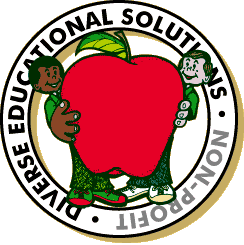 The Third Annual CLD Institute in Garden City, Kansas,
on July 28th and 29th, 2003, brought 150 educators together
to learn from and share with workshop presenters whose
names read like a "Who's Who" of current research and
practice in the instruction of students from different
language and culture backgrounds. The hardest decision
for institute participants was choosing among the great
selection of one-day and two-day workshops, on topics
ranging from early childhood literacy to cross-cultural
dynamics of education for CLD students.
The Third Annual CLD Institute in Garden City, Kansas,
on July 28th and 29th, 2003, brought 150 educators together
to learn from and share with workshop presenters whose
names read like a "Who's Who" of current research and
practice in the instruction of students from different
language and culture backgrounds. The hardest decision
for institute participants was choosing among the great
selection of one-day and two-day workshops, on topics
ranging from early childhood literacy to cross-cultural
dynamics of education for CLD students.
 I spent both days in a room with about 40 elementary
school teachers from the Garden City area, learning
about "Elementary Education Sheltered Instruction,"
facilitated by Jo Gusman, of the Sacramento, California,
school system.
I spent both days in a room with about 40 elementary
school teachers from the Garden City area, learning
about "Elementary Education Sheltered Instruction,"
facilitated by Jo Gusman, of the Sacramento, California,
school system.
 Jo Gusman has been teaching in California schools
since 1974, and reassured workshop participants that
the current standards craze and seemingly endless
rounds of high-stakes testing which teachers are
stressing under will eventually
pass. "Teachers are responsible today for so many
different sets of standards that the key is to bundle
the standards," she says. "Teachers need time to be
creative again." Gusman shared two of her favorite
quotes to help us understand the personal philosophy
which informs her teaching approach. The first is
a simple idea from Henry David Thoreau: "Less is more."
The second is from Marcel Proust: "The real voyage of
discovery consists not in seeing new landscapes but
in having new eyes."
Jo Gusman has been teaching in California schools
since 1974, and reassured workshop participants that
the current standards craze and seemingly endless
rounds of high-stakes testing which teachers are
stressing under will eventually
pass. "Teachers are responsible today for so many
different sets of standards that the key is to bundle
the standards," she says. "Teachers need time to be
creative again." Gusman shared two of her favorite
quotes to help us understand the personal philosophy
which informs her teaching approach. The first is
a simple idea from Henry David Thoreau: "Less is more."
The second is from Marcel Proust: "The real voyage of
discovery consists not in seeing new landscapes but
in having new eyes."
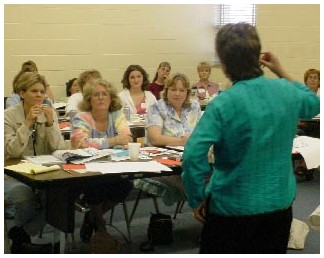 Her perspective as someone who weathered intolerance
as a student makes Jo Gusman an effective proponent
of inclusion. The worst offense a child in one of her
classes can commit is to not be inclusive, she explains.
Her perspective as someone who weathered intolerance
as a student makes Jo Gusman an effective proponent
of inclusion. The worst offense a child in one of her
classes can commit is to not be inclusive, she explains.
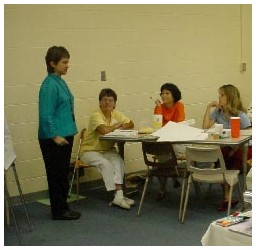 "I was shocked to find I didn't know what to do," explains
Gusman. "I found myself staying later and later after school.
I had to rewrite all my lesson plans." Five months into the
school year, she felt she was still at the same phase and
remembers sitting at her desk crying. "I became paralyzed,"
says Jo Gusman, "and I didn't want to tell anybody." She
had hit "rock bottom."
"I was shocked to find I didn't know what to do," explains
Gusman. "I found myself staying later and later after school.
I had to rewrite all my lesson plans." Five months into the
school year, she felt she was still at the same phase and
remembers sitting at her desk crying. "I became paralyzed,"
says Jo Gusman, "and I didn't want to tell anybody." She
had hit "rock bottom."
2. Who are all of these people?
3. What are we doing today?
 "Never forget," says Jo Gusman, "you sound like Charlie
Brown's teacher." That is why it is so important, she
explains, to "set up a communication system in a language
that isn't dependent on English." One of the many analogies
she used was an airport ground crew using Day-Glo wands to
guide aircraft at night, just as teachers need to use
visually distinctive objects to help orient their students
in the classroom.
"Never forget," says Jo Gusman, "you sound like Charlie
Brown's teacher." That is why it is so important, she
explains, to "set up a communication system in a language
that isn't dependent on English." One of the many analogies
she used was an airport ground crew using Day-Glo wands to
guide aircraft at night, just as teachers need to use
visually distinctive objects to help orient their students
in the classroom.
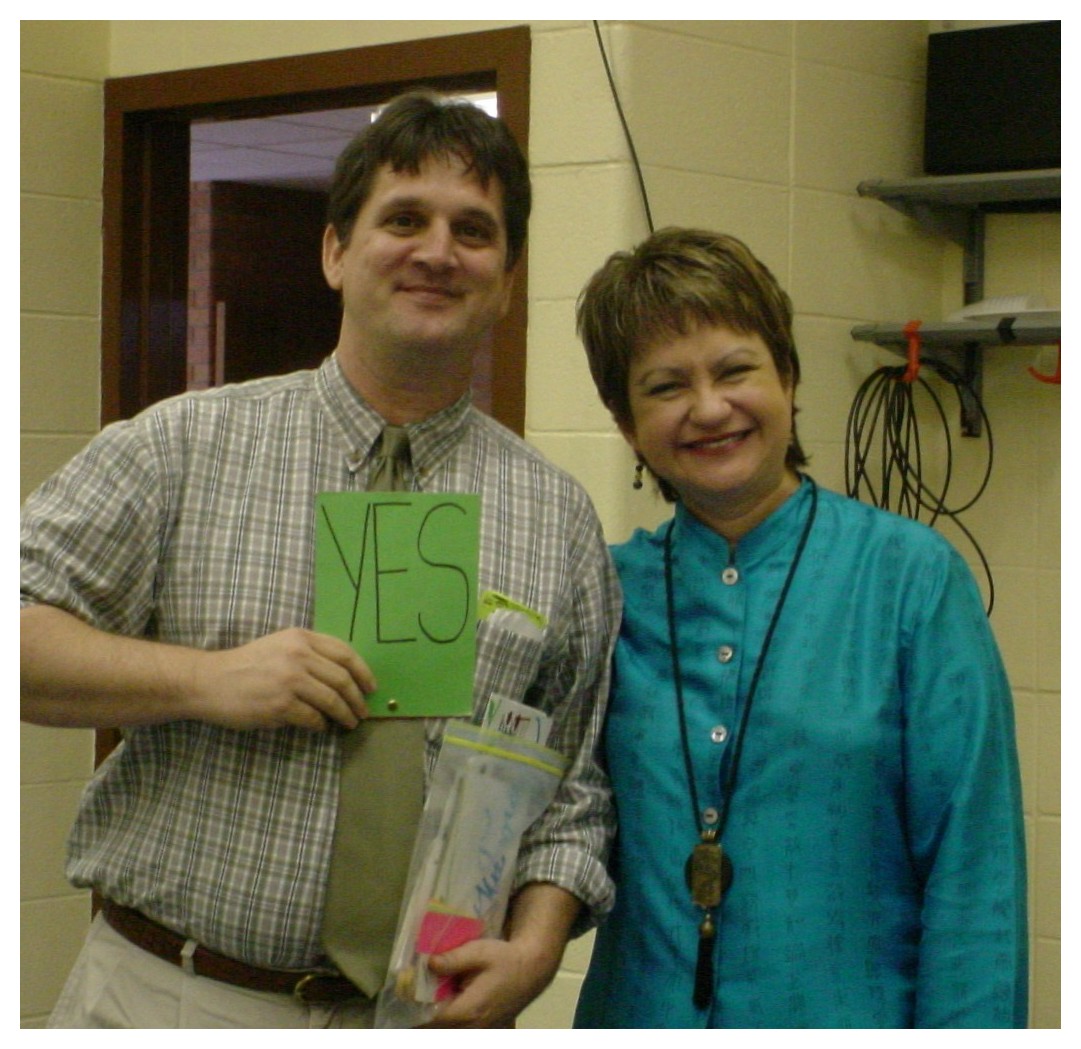 In the workshop, we made "Yes/No Fans," with green
and red construction paper and paper fasteners. On
the green sheet, we wrote "Yes" on one side and "Si"
on the reverse; on the red sheet, "No" and "No." In
a large classroom with many students, this simple
communication system allows everyone to respond at
once to Yes/No questions from the teacher. Jo Gusman
doesn't want her students to wave their answers wildly
in the air; instead, she has them hold the answer over
their hearts so that she can see it. This procedural
matter led her to explain further brain research which,
she says, suggests that the human skin is actually the
outer layer of our brain, and that the human mind
actually resides everywhere in the body. Sources for
this data are Candace Pert (The Molecules of Emotion)
and Robert Sylwester (A Celebration of Neurons: An Educator's
Guide to the Human Brain).
In the workshop, we made "Yes/No Fans," with green
and red construction paper and paper fasteners. On
the green sheet, we wrote "Yes" on one side and "Si"
on the reverse; on the red sheet, "No" and "No." In
a large classroom with many students, this simple
communication system allows everyone to respond at
once to Yes/No questions from the teacher. Jo Gusman
doesn't want her students to wave their answers wildly
in the air; instead, she has them hold the answer over
their hearts so that she can see it. This procedural
matter led her to explain further brain research which,
she says, suggests that the human skin is actually the
outer layer of our brain, and that the human mind
actually resides everywhere in the body. Sources for
this data are Candace Pert (The Molecules of Emotion)
and Robert Sylwester (A Celebration of Neurons: An Educator's
Guide to the Human Brain).
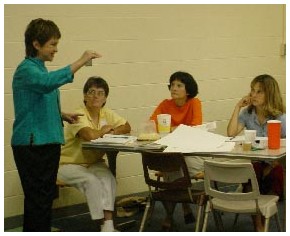 Gusman very
strongly believes that physical movement and coordination
exercises are intimately connected to cognitive activity. She
herself was continually moving around the room throughout
the entire 12-hour, two-day workshop, gesturing with her
hands and her face to accentuate each point, and constantly
throwing out reflection questions ("How many of you...?")
to the audience. These were never single questions, but
rather in series, so that, for example, if she asked how
many of us were classroom teachers and a certain number
of hands were raised, she would modify the question so
that administrators, paraeducators and teacher educators,
in turn, would be included. Every time Jo Gusman asks
a "How many of you.." question, she redirects it again
and again until every member of the group has been included.
Gusman very
strongly believes that physical movement and coordination
exercises are intimately connected to cognitive activity. She
herself was continually moving around the room throughout
the entire 12-hour, two-day workshop, gesturing with her
hands and her face to accentuate each point, and constantly
throwing out reflection questions ("How many of you...?")
to the audience. These were never single questions, but
rather in series, so that, for example, if she asked how
many of us were classroom teachers and a certain number
of hands were raised, she would modify the question so
that administrators, paraeducators and teacher educators,
in turn, would be included. Every time Jo Gusman asks
a "How many of you.." question, she redirects it again
and again until every member of the group has been included.
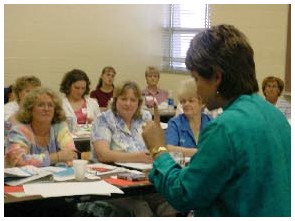 After going over activities to give everybody many
chances to respond to meaningful input, Jo Gusman returned
to the other key element in a successful English language
learning experience for newcomers in our classrooms: reducing
the affective filter by establishing an atmosphere of trust.
Trust is the first step in creating a productive and inclusive
learning community, according to Gusman. "Take all the time
that it takes to create trust," she adds.
After going over activities to give everybody many
chances to respond to meaningful input, Jo Gusman returned
to the other key element in a successful English language
learning experience for newcomers in our classrooms: reducing
the affective filter by establishing an atmosphere of trust.
Trust is the first step in creating a productive and inclusive
learning community, according to Gusman. "Take all the time
that it takes to create trust," she adds.
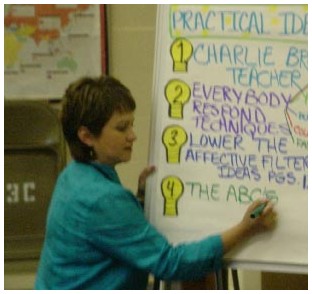 Jo Gusman concluded her two-day workshop with
an overview of the National Reading Panel's
key elements of reading instruction, and
how to address these while not sacrificing
all your efforts at reducing affective filters,
increasing comprehensible input and, in general,
maintaining a meaning-rich classroom environment.
Since federal funding for "Reading First"
programs is heavily slanted in favor of the
NRC's dictates, it is important for teachers
to be certain their reading instruction addresses
the five NRC elements of reading: vocabulary,
comprehension, phonics, phonemic awareness
and fluency.
Jo Gusman concluded her two-day workshop with
an overview of the National Reading Panel's
key elements of reading instruction, and
how to address these while not sacrificing
all your efforts at reducing affective filters,
increasing comprehensible input and, in general,
maintaining a meaning-rich classroom environment.
Since federal funding for "Reading First"
programs is heavily slanted in favor of the
NRC's dictates, it is important for teachers
to be certain their reading instruction addresses
the five NRC elements of reading: vocabulary,
comprehension, phonics, phonemic awareness
and fluency.
Jo Gusman
3101 Miramar Road
Sacramento, California 95821-6134
(916) 482-4405
You Had to Be There...
This article about Jo Gusman's recent workshop at the Garden City CLD Summer Institute has failed to convey the enthusiasm for teaching and the sensitivity for different cultural and linguistic perspectives she demonstrated. The above list of practical ideas only touches the surface of the many relevant suggestions Gusman gave during two full days of non-stop instruction. "Some of these ideas will be 'keepers,'" she explained at the start, meaning new activities teachers can use right away. "Others will be 'polishers,'" she added, meaning ways to enhance what we are already doing, because, as her principal at the newcomer school in Sacramento told her back in 1981, "even silver and gold need polishing."
Jo Gusman motivated and challenged 40 teachers in Garden City to go back to school this fall with a renewed determination to help their students succeed. And she gave everyone dozens of ideas and activities to make it happen. "Turn to the person next to you," she said near the end of the two-day seminar, "and tell them 'I am so privileged to sit next to you because you get it.'"
The genius of Jo Gusman's approach to teacher education is that we did indeed feel, for at least that one fleeting moment, like we did really get it. And that experience of that feeling sticks with you, pushing you to recreate it in your own teaching.
I was walking on air as I headed out of this year's CLD Summer Institute in Garden City. I have a greater sense of confidence that I can make a positive difference at school this year.
I understand better than ever before why our teachers, especially our elementary school teachers, deserve our unending gratitude and respect. And I believe, based on Jo Gusman's message, that more and more children from diverse and at-risk backgrounds will have positive school experiences which evoke the same gratitude and respect.
Story by Robb Scott, Hays, KANSAS
Robb@ESLminiconf.net
2003 ESL MiniConference Online